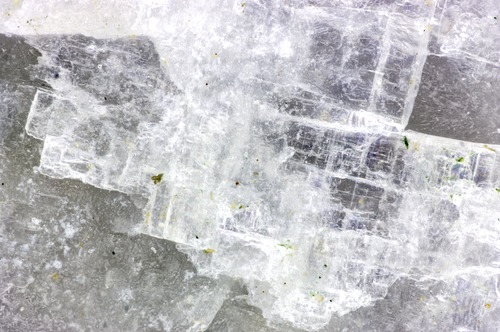Searlesite
A valid IMA mineral species - grandfathered
This page is currently not sponsored. Click here to sponsor this page.
About Searlesite
Formula:
Na(H2BSi2O7)
Colour:
White, light brown
Lustre:
Vitreous, Pearly
Hardness:
3½
Specific Gravity:
2.44 - 2.46
Crystal System:
Monoclinic
Name:
Named after John Wemple Searles (November 16, 1828 Tribes Hill, New York, USA - October 7, 1897 St. Helena, California, USA), California pioneer and discoverer of Searles Lake, USA.
The structure of Searlesite contains sheets, consisting of kinked pyroxene-like polysilicate chains that are linked by (H2BO4) tetrahedra, classifying it as a phyllo-borosilicate. The silicate chains contain two crystallographically distinct Si sites, and the net formula of the anion is (H2BSi2O7)n with (H2BSi2O7) as repeating unit (Ghose and Wan, 1976). Note that we are using a sum formula for the anion. It may also be written as (BSiO5(OH)2), indicating that the two protons are bonded to oxygen atoms.
Unique Identifiers
Mindat ID:
3600
Long-form identifier:
mindat:1:1:3600:5
GUID
(UUID V4):
(UUID V4):
7762ec3a-e8a9-4493-831d-43770d8b2d10
IMA Classification of Searlesite
Approved, 'Grandfathered' (first described prior to 1959)
IMA Formula:
NaBSi2O5(OH)2
First published:
1914
Type description reference:
Classification of Searlesite
9.EF.15
9 : SILICATES (Germanates)
E : Phyllosilicates
F : Single nets with 6-membered rings, connected by M[4], M[8], etc.
9 : SILICATES (Germanates)
E : Phyllosilicates
F : Single nets with 6-membered rings, connected by M[4], M[8], etc.
71.3.5.4
71 : PHYLLOSILICATES Sheets of Six-Membered Rings
3 : Sheets of 6-membered rings with 2:1 clays
71 : PHYLLOSILICATES Sheets of Six-Membered Rings
3 : Sheets of 6-membered rings with 2:1 clays
17.5.3
17 : Silicates Containing other Anions
5 : Borosilicates
17 : Silicates Containing other Anions
5 : Borosilicates
Mineral Symbols
As of 2021 there are now IMA–CNMNC approved mineral symbols (abbreviations) for each mineral species, useful for tables and diagrams.
| Symbol | Source | Reference |
|---|---|---|
| Sle | IMA–CNMNC | Warr, L.N. (2021). IMA–CNMNC approved mineral symbols. Mineralogical Magazine, 85(3), 291-320. doi:10.1180/mgm.2021.43 |
Physical Properties of Searlesite
Vitreous, Pearly
Transparency:
Transparent
Comment:
Vitreous, slightly pearly on cleavage surfaces
Colour:
White, light brown
Hardness:
3½ on Mohs scale
Tenacity:
Brittle
Cleavage:
Perfect
Perfect on {100}, imperfect on {102}, {010}
Perfect on {100}, imperfect on {102}, {010}
Density:
2.44 - 2.46 g/cm3 (Measured) 2.46 g/cm3 (Calculated)
Optical Data of Searlesite
Type:
Biaxial (-)
RI values:
nα = 1.516 nβ = 1.531 nγ = 1.535
2V:
Measured: 55°
Max Birefringence:
δ = 0.019

Image shows birefringence interference colour range (at 30µm thickness)
and does not take into account mineral colouration.
and does not take into account mineral colouration.
Surface Relief:
Low
Dispersion:
none
Chemistry of Searlesite
Mindat Formula:
Na(H2BSi2O7)
Common Impurities:
Al,Fe,Mg,H2O
Crystallography of Searlesite
Crystal System:
Monoclinic
Class (H-M):
2 - Sphenoidal
Space Group:
P21
Setting:
P21
Cell Parameters:
a = 7.9814(12) Å, b = 7.0657(8) Å, c = 4.9054(4) Å
β = 93.95(1)°
β = 93.95(1)°
Ratio:
a:b:c = 1.13 : 1 : 0.694
Unit Cell V:
275.98 ų (Calculated from Unit Cell)
Z:
2
Morphology:
Flat crystals, to 17 cm, occur along bedding planes. Commonly as spherulitic aggregates of radiating acicular to prismatic crystals; as massive granular aggregates.
Crystal Structure
Load
Unit Cell | Unit Cell Packed
2x2x2 | 3x3x3 | 4x4x4
Unit Cell | Unit Cell Packed
2x2x2 | 3x3x3 | 4x4x4
Show
Big Balls | Small Balls | Just Balls | Spacefill
Polyhedra Off | Si Polyhedra | All Polyhedra
Remove metal-metal sticks
Big Balls | Small Balls | Just Balls | Spacefill
Polyhedra Off | Si Polyhedra | All Polyhedra
Remove metal-metal sticks
Display Options
Black Background | White Background
Perspective On | Perspective Off
2D | Stereo | Red-Blue | Red-Cyan
Black Background | White Background
Perspective On | Perspective Off
2D | Stereo | Red-Blue | Red-Cyan
View
CIF File Best | x | y | z | a | b | c
CIF File Best | x | y | z | a | b | c
Rotation
Stop | Start
Stop | Start
Labels
Console Off | On | Grey | Yellow
Console Off | On | Grey | Yellow
Data courtesy of the American Mineralogist Crystal Structure Database. Click on an AMCSD ID to view structure
| ID | Species | Reference | Link | Year | Locality | Pressure (GPa) | Temp (K) |
|---|---|---|---|---|---|---|---|
| 0000498 | Searlesite | Ghose S, Wan C (1976) Structural chemistry of borosilicates, part II: Searlesite, NaBSi2O5(OH): Absolute configuration, hydrogen locations, and refinement of the structure American Mineralogist 61 123-129 |  | 1976 | 0 | 293 |
CIF Raw Data - click here to close
X-Ray Powder Diffraction
Powder Diffraction Data:
| d-spacing | Intensity |
|---|---|
| 8.01 Å | (100) |
| 4.06 Å | (50) |
| 3.48 Å | (40) |
| 3.24 Å | (40) |
| 4.31 Å | (30) |
| 3.54 Å | (30) |
| 3.21 Å | (30) |
Geological Environment
Paragenetic Mode(s):
| Paragenetic Mode | Earliest Age (Ga) |
|---|---|
| Near-surface Processes | |
| 25 : Evaporites (prebiotic) | |
| Stage 10a: Neoproterozoic oxygenation/terrestrial biosphere | <0.6 |
| 50 : Coal and/or oil shale minerals | <0.36 |
Geological Setting:
Commonly interbedded with oil shales or marls (Green River Formation, USA); in boron-bearing evaporite deposits (California, USA); rarely in vugs in phonolite (Point of Rocks,New Mexico, USA).
Type Occurrence of Searlesite
Co-Type Localities:
General Appearance of Type Material:
Nearly white spherulites about a millimeter in diameter, composed of fairly well-formed, radiating fibers. Massive.
Place of Conservation of Type Material:
Harvard University, Cambridge, Massachusetts, 81274; National Museum of Natural History, Washington, D.C., USA, R6457, 93270, 94734, 96080, 124352.
Geological Setting of Type Material:
Boron bearing playa deposits.
Associated Minerals at Type Locality:
Reference:
Larsen, E.S., Hicks, W.B. (1914) Searlesite, a new mineral. American Journal of Science: 38: 437-440.
Other Language Names for Searlesite
Common Associates
Associated Minerals Based on Photo Data:
| 6 photos of Searlesite associated with Loughlinite | Na2Mg3Si6O16 · 8H2O |
| 5 photos of Searlesite associated with Baryte | BaSO4 |
| 4 photos of Searlesite associated with Aegirine | NaFe3+Si2O6 |
| 2 photos of Searlesite associated with Tincalconite | Na2(B4O7) · 5H2O |
| 1 photo of Searlesite associated with Chalcedony | SiO2 |
| 1 photo of Searlesite associated with Ulexite | NaCa[B5O6(OH)6] · 5H2O |
| 1 photo of Searlesite associated with Calcite | CaCO3 |
| 1 photo of Searlesite associated with Stillwellite-(Ce) | (Ce,La,Ca)BSiO5 |
| 1 photo of Searlesite associated with Reedmergnerite | NaBSi3O8 |
Related Minerals - Strunz-mindat Grouping
| 9.EF.05 | Petalite | LiAl(Si4O10) |
| 9.EF.10 | Sanbornite | Ba2(Si4O10) |
| 9.EF.20 | Silinaite | NaLiSi2O5 · 2H2O |
| 9.EF.25 | Kanemite | HNaSi2O5 · 3H2O |
| 9.EF.30 | Yakovenchukite-(Y) | K3NaCaY2[Si12O30] · 4H2O |
Fluorescence of Searlesite
may fluoresce green under SW UV.
Other Information
Electrical:
Piezoelectric
Health Risks:
No information on health risks for this material has been entered into the database. You should always treat mineral specimens with care.
Internet Links for Searlesite
mindat.org URL:
https://www.mindat.org/min-3600.html
Please feel free to link to this page.
Please feel free to link to this page.
Search Engines:
External Links:
References for Searlesite
Reference List:
Rogers, A.F. (1924). The crystallography of searlesite. American Journal of Science: 5(42): 498-502.
Foshag, William F. (1934) Searlesite from Esmeralda County, Nevada. American Mineralogist, 19 (6) 268-274
Localities for Searlesite
Locality List
 - This locality has map coordinates listed.
- This locality has map coordinates listed.
 - This locality has estimated coordinates.
ⓘ - Click for references and further information on this occurrence.
? - Indicates mineral may be doubtful at this locality.
- This locality has estimated coordinates.
ⓘ - Click for references and further information on this occurrence.
? - Indicates mineral may be doubtful at this locality.
 - Good crystals or important locality for species.
- Good crystals or important locality for species.
 - World class for species or very significant.
(TL) - Type Locality for a valid mineral species.
(FRL) - First Recorded Locality for everything else (eg varieties).
- World class for species or very significant.
(TL) - Type Locality for a valid mineral species.
(FRL) - First Recorded Locality for everything else (eg varieties).
All localities listed without proper references should be considered as questionable.
Quick NavTopAbout SearlesiteUnique IdentifiersIMA Classification Classification Mineral SymbolsPhysical Properties Optical Data Chemistry Crystallography Crystal StructureX-Ray Powder DiffractionGeological EnvironmentType Occurrence Other LanguagesCommon AssociatesStrunz-MindatFluorescence Other InformationInternet Links References Localities Locality List








 symbol to view information about a locality.
The
symbol to view information about a locality.
The 



Rio Tinto Borax open pit, Rio Tinto Borax Mine, Kramer Borate deposit, Boron, Kern County, California, USA